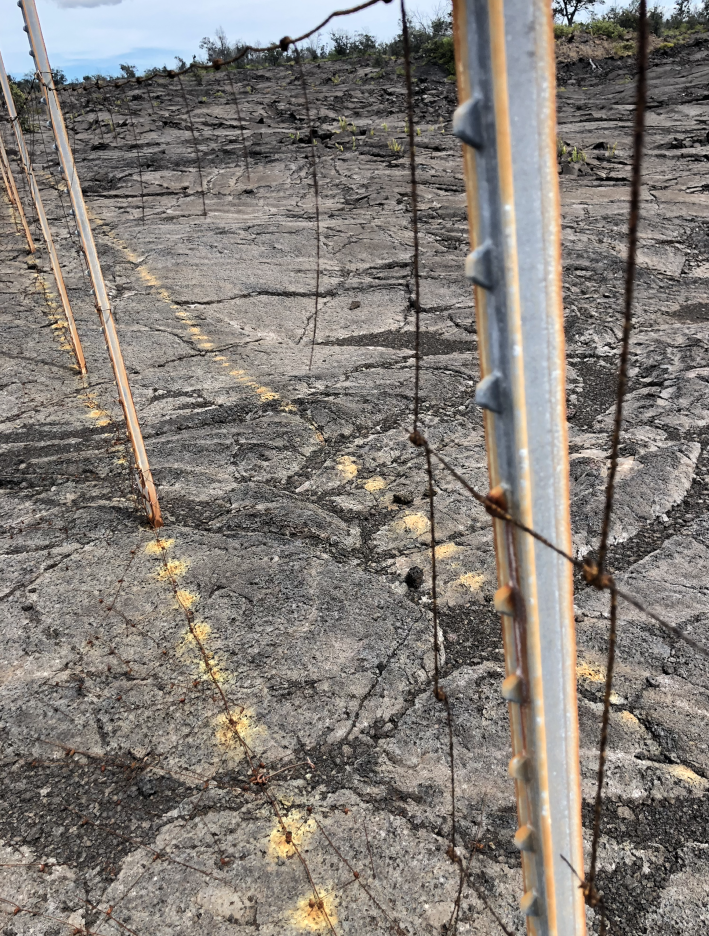Last updated: February 22, 2023
Article
Perimeter Fencing at Three Hawaiʻi Parks to be Reconstructed Through GAOA Funding to Protect Unique Park Ecosystems

NPS Photo
Three Hawaiʻi National Parks, with funding through the Great American Outdoors Act, will reconstruct approximately 64 miles of perimeter exclusionary fencing segments most likely to fail. Perimeter exclusionary fencing is a type of fencing used to keep invasive animals outside of protected areas and continues to be an effective tool used to support the protection of those area’s ecosystems from damage. Exclusionary fencing has been instrumental in achieving over 20 years of ecosystem recovery. A single failure in the fencing could open these ecosystems to extensive damage from non-native, feral goats, deer, sheep, cattle, pigs, dogs, and cats that exist just outside of the fencing.
Protection of native ecosystems and watersheds is important to both Native Hawaiian people and the National Park Service. These parks play an important role in interpreting Hawaiian culture and protecting some of the most unique geological and biological landscapes in the world.
-
Haleakalā National Park vibrates with stories of ancient and modern Hawaiian culture and protects the bond between the land and its people. Visitors to the park enjoy photographing the signature Silversword and colorful endangered songbirds native to the sub-tropical rain forests of Maui. The rare forest birds are in a race for survival due to changing climate and habitat damage from feral animals.
-
Hawaiʻi Volcanoes National Park, an International Biosphere Reserve and UNESCO World Heritage Site, protects some of the most unique and cherished geological, biological, and cultural landscapes in the world.
-
Kalaupapa National Historical Park, in addition to preserving its significant history, protects federally threatened and endangered plant species. Pamakani, or Tetramolopium rockii, is only found in fenced enclosures within the park. Additionally, the fencing protects native coastal spray vegetation, heiau rock walls, and other structures built by Native Hawaiians.
The current fencing has exceeded its projected life in the corrosive volcanic and sea-air environments. The project will replace and upgrade 40 miles of fencing segments at Hawaiʻi Volcanoes National Park, 15 miles at Haleakalā National Park, and nine miles at Kalaupapa National Historical Park. Contracted helicopters will be required to transport fence materials to remote areas because most of the exclusionary fencing is in remote and extremely difficult terrain. The project will also rehabilitate four dilapidated Hawaiʻi Volcanoes National Park resource management buildings (maintenance greenhouse, greenhouse office, potting shed, and insect quarantine bughouse) associated with plant propagation for plant protection efforts.
Project at a Glance: This $30.5 million project will reconstruct approximately 64 miles of existing perimeter exclusionary fencing segments that have exceeded their life at three Hawaiʻi parks: Hawaiʻi Volcanoes National Park, Haleakalā National Park, and Kalaupapa National Historical Park. The new fencing will exclude non-native, feral goats, deer, sheep, cattle, pigs, dogs, and cats to protect fragile and unique native species from devastating damage.
What are the Benefits: This project will protect the integrity of the unique ecosystems at Hawaiʻi Volcanoes National Park, Haleakalā National Park, and Kalaupapa National Historical Park from grazing and trampling damage by feral and predatory animals that threaten endangered flora and fauna—ultimately saving Park biocultural resources to protect the bond between the land and its people. Continuing to use exclusionary fencing preserves over 50 federally listed threatened and endangered species and their critical habitat, removes a key stressor on Hawaii’s native species and ecosystems, and thereby increases their resilience to climate change impacts. Additionally, protecting these resources safeguards the experience for 3.2 million annual visitors of seeing, experiencing, and learning about these parks.
Project Purpose and Goals
-
Replace a total of 64 miles of exclusionary perimeter fencing most urgently in need of replacement in Hawaiʻi Volcanoes National Park, Haleakalā National Park, and Kalaupapa National Historical Park
-
Help prevent erosion and damage to park trails, campsites, front country areas, cultural landscapes, archeological features and deterioration of downslope water quality
-
Reduce expenses related to animal control and revegetation efforts
-
Mitigate the potential for dangerous non-native wildlife encounters
-
Ensure new fencing is stable for 20 years
-
Correct $36.2 million of high priority deferred maintenance and repairs
Find more information about Great American Outdoors Act projects
Progress Images

NPS Photo

NPS Photo






